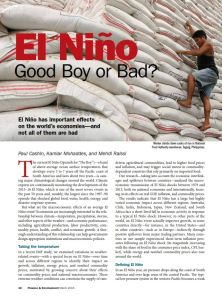Melden Sie sich bei getAbstract an, um die Zusammenfassung zu erhalten.

Melden Sie sich bei getAbstract an, um die Zusammenfassung zu erhalten.
Paul Cashin, Kamiar Mohaddes and Mehdi Raissi
El Niño
Good Boy or Bad?
Finance & Development , 2016
Was ist drin?
El Niño brings big changes to the world’s climates every few years, but how does it affect economies?
Recommendation
El Niño is now a household term, as people worldwide confront the severe effects of its 2015–2016 episode. However, El Niño is not all bad, say economists Paul Cashin, Kamiar Mohaddes and Mehdi Raissi. Their concise article looks into the economic impact of El Niño on different countries and on the global economy. The weather pattern has boosted output in some nations, but it also tends to stoke global inflation by hiking the prices of some commodities. While the article contains good information, its prose is a bit dry. Nonetheless, getAbstract recommends it to policy makers, executives and anyone interested in the nexus between economics and climate.
Summary
About the Authors
Paul Cashin and Mehdi Raissi are economists at the International Monetary Fund. Kamiar Mohaddes is a senior lecturer and fellow at Girton College, University of Cambridge.



















Comment on this summary